
by Sheila Dunning | Mar 2, 2018
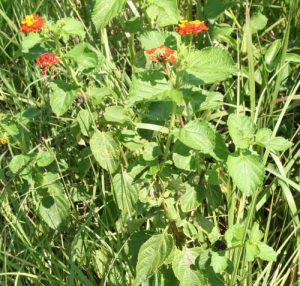
Lantana is a landscape plant that easily escapes cultivation and spreads. Photo Credit: Jennifer Bearden
You know that plant in the corner of the yard that seems to be taking over? It’s the one that your friend “passed along” because they had plenty of them and wanted to share. After all, it grows so well. How can you go wrong?
The odds are that vigorous plant is a non-native species. The majority of what is sold in nurseries are introduced from a foreign country and developed for their uniqueness. The problem is that many of the plants brought into the United States arrive without their natural enemies. Under the long, warm growing season found in Florida, these non-native plants become the dominant plant in an area and manage to out-compete the native plants. When this happens, these introduced plants get labeled as an “invasive species”.
These invasive species threaten Florida’s environment, economy and health, requiring an estimated $120 billion a year to control them. Learning which of these plants have the potential to become invasive has been a focus of researchers with the UF/IFAS Center for Aquatic and Invasive Plants. They have spent more than a year developing a searchable website and database to help Floridians assess problem non-native plants. The website features more than 800 species, is easily searchable by common or scientific name, and the results can be filtered. The site helps predict the invasive potential. Each species is categorized as “caution”, “invasive not recommended”, or “prohibited” based on their ecological threat.
If you want to learn more about your friend’s ”passalong” plant be sure to visit the Assessment of Nonnative Plants in Florida’s Natural Areas website and database. Also check the FLEPPC (Florida Exotic Pest Plant Council) list. Also make sure new plants are not on the Florida Noxious Weed List or the Federal Noxious Weed List.
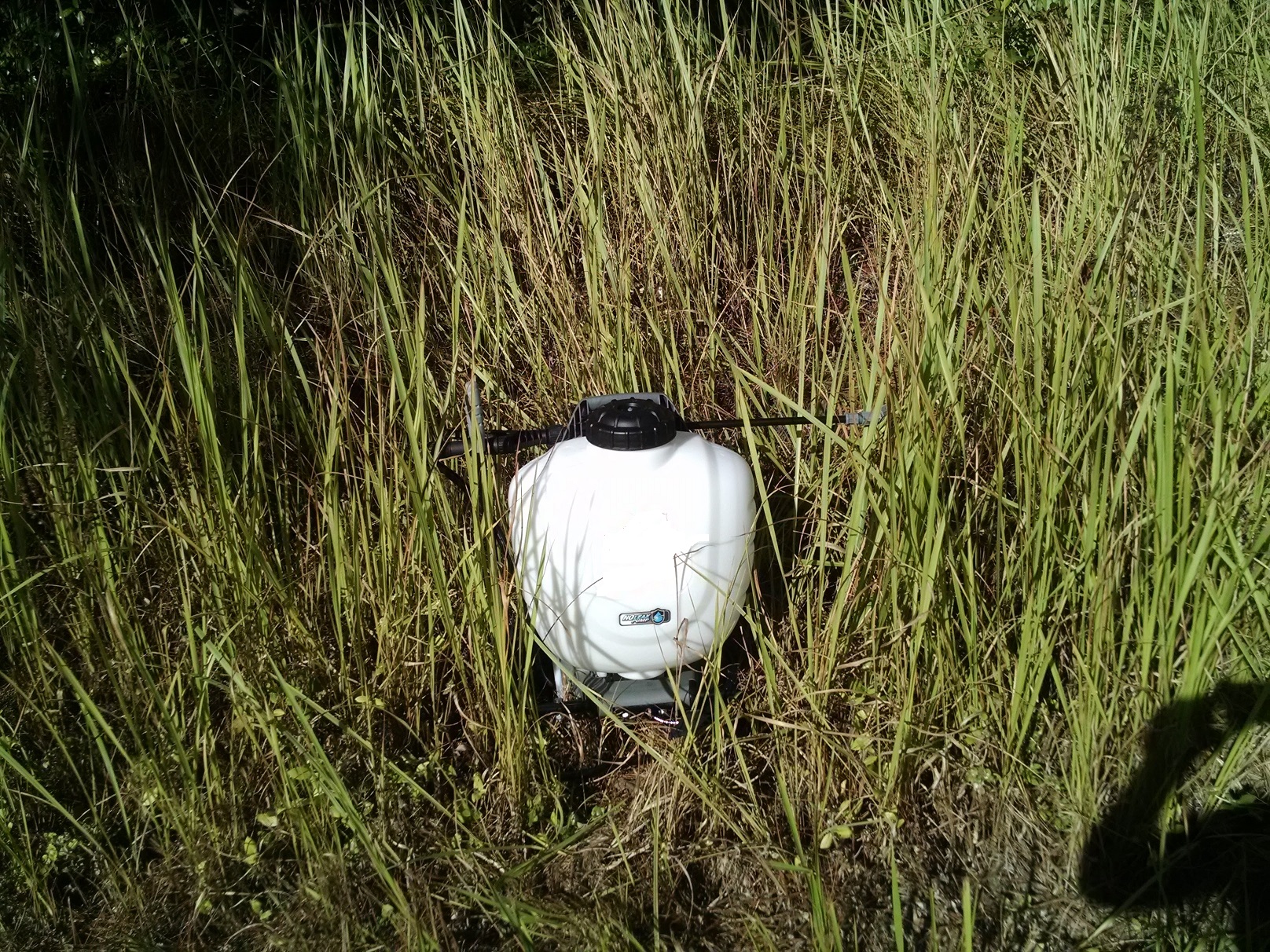
by Mark Mauldin | Mar 1, 2018
Chemical (Herbicide) treatments, while not the only option, are often required for effective control of woody invasive species. When treating woody invasive species there are three common, relatively simple techniques for applying herbicide; Foliar, Basal, and Cut Stump.
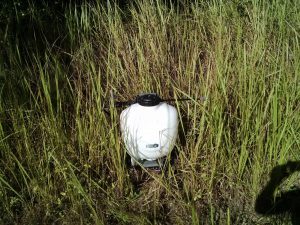
Foliar applications are the only option for invasive grasses like cogongrass. Photo Credit: Jennifer Bearden
Foliar Applications – spray solution is applied directly to leaves. For these applications to be effective leaves must be present and actively growing. Additionally, plants should not be disturbed for several weeks after the application. The herbicide must have time to move throughout the entire plant. Remember, the goal is killing plants, not leaves. Perennial plants can handle losing their leaves; they go through that process every year.
There are some points to consider when making foliar applications. The height of the plants being treated should not exceed 6-8ft. As the height of the plants increase, spray drift management becomes more of a concern. Upward spraying of herbicide greatly increases the likelihood of injuring non-target plants. Adequate coverage is another important consideration for foliar applications. All leaves need to be covered but not to the point of runoff. The timing of the application is also important; foliar sprays on perennial plants are generally the most effective in the late summer – early fall when the plants are naturally translocating product into their roots preparing for winter dormancy. This process facilitates the movement of herbicide into the roots.
Foliar applications are the only option for invasive grasses, they can be effective on shrubs, but are less than ideal for trees. The ratio of leaf area to total biomass is key to the effectiveness of foliar treatments; grasses are nearly all leaf, shrubs are relatively small and generally fairly leafy, trees can be very large with relatively few leaves making effective foliar treatments rather difficult. Retreatment is often needed to acquire complete control of trees and large shrubs.
As the name implies, individual plant treatments treat one plant at a time. These treatments are very effective, selective, and labor intensive. The two most straightforward kinds of individual plant treatment are basal and cut-stump applications.
Simply put, basal treatments involve applying an herbicide mixed with an oil penetrant directly to the bottom 12-18 inches of a standing tree or shrub. For basal treatments to be consistently effective trees need to be less than 6 inches in diameter and have smooth bark. Additionally, the bottom 12-18 inches of the stem need to be completely coated with herbicide/oil mixture. Results are very slow, often months. Basal treatments can be successful any time of year except during the “spring flush” when the upward sap flow impedes herbicide translocation. It should be noted that basal treatments will result in standing, dead trees and shrubs.
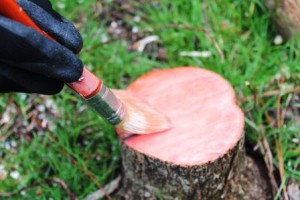
Cut stump treatment of removed tree prevents regrowth and is often used when controlling invasive species.
Cut-stump treatments involve applying a high concentration of herbicide directly to the freshly cut stump of an unwanted tree or shrub. The herbicide application prevents regrowth and suckering. These treatments are highly dependable and effective any time of year other than during the “spring flush”, as described above. For larger, thicker barked trees cut –stump treatments are the most dependable control option.
Follow the link below for additional information and for specific chemical recommendations to use with an of these techniques contact your county’s UF/IFAS Extension Office: Herbicide Techniques for Woody Plant Control
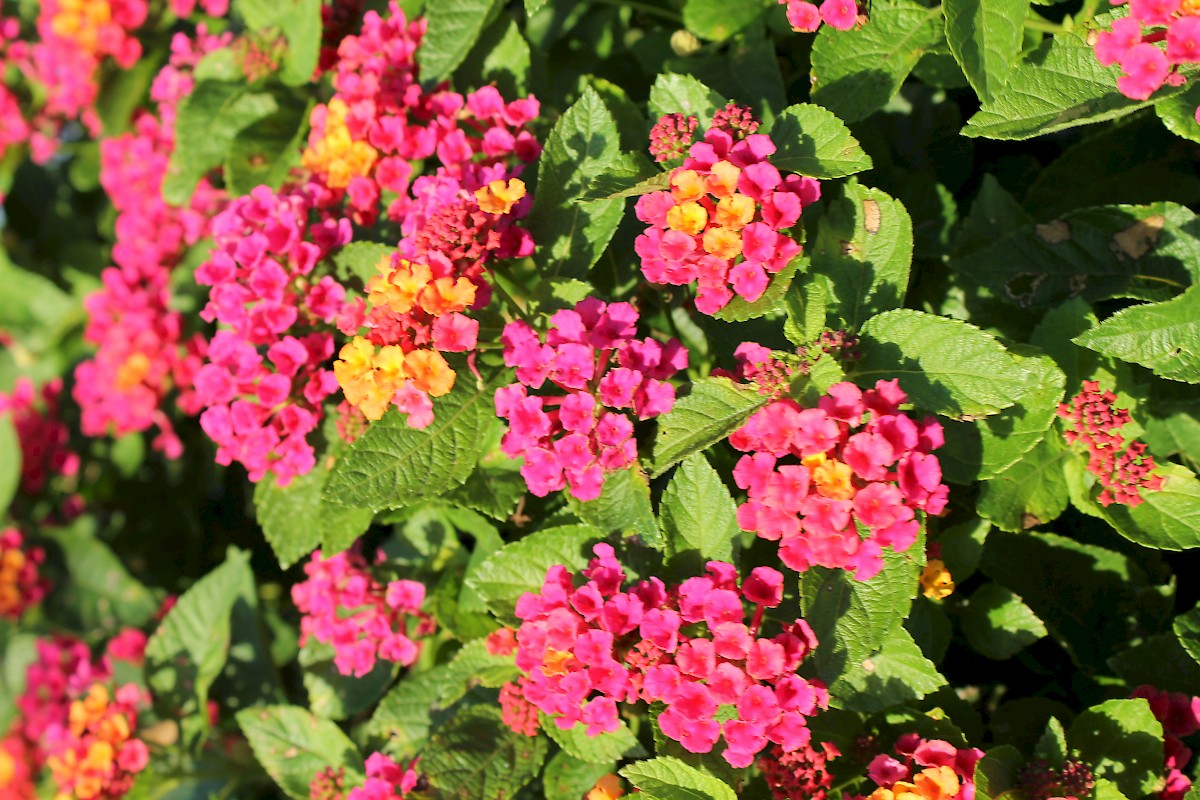
by Sheila Dunning | Mar 1, 2018
An invasive plant is defined as a plant that is non-native to the ecosystem under consideration and whose introduction causes or is likely to cause economic or environmental harm or harm to human health (National Invasive Species Council, 2001). Research supports the fact that invasive plants damage natural areas, but there is great debate over which plants are invasive and where they are causing problems. Many lists of invasive plants have been complied by government agencies or environmental groups such as the Florida Exotic Pest Plant Council (www.fleepc.org) that include plants currently available at nurseries. Examples of such plants are Mexican petunia, Lantana and Porterweed.
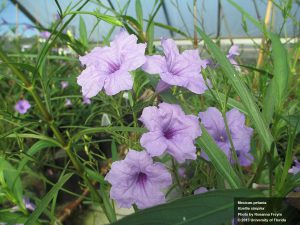
Mexican Petunia
The bright color and rapid growth of Mexican petunia (Ruellia tweediana or R. brittoniana) has resulted in mass plantings that disrupt native wetland systems. The species is not used by butterflies, contrary to published misinformation. On the other hand, Porterweed is attractive to butterflies and the deep blue flower color of Stachytarpheta urticifolia has proven to be equally popular with gardeners. Additionally, Lantana camara is a favorite of Lepidoptera and a prolific bloomer, so hundreds of plants are installed in the landscape annually, spreading viable seed throughout the neighborhood and woods. Unfortunately, when it is found in natural areas it is difficult to distinguish the native lantana (L. depressa) from the invasive lantana (L. camara) and the two species can hybridize, making accurate identification even harder.
In fact, all three plants have native cousins with acceptable growth habits. Drought tolerant Ruellia caroliniensis has a pale violet-colored flower that serves as a host plant to the Buckeye butterfly. Stachytarpheta urticifolia is a low-growing groundcover with pale blue flowers. If the Porterweed is growing tall and upright, it is not the native. Leaf characteristics can be used to distinguish the native lantana (L. depressa) from the invasive lantana (L. camara). Native lantana has a tapered leaf base, whereas the invasive lantana has a truncate leaf base.
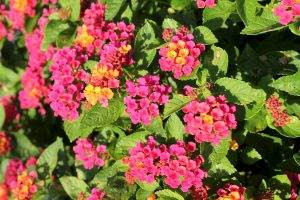
Lantana camara
Cultivars of species may have characteristics making them less invasive (Wood, 2007). University of Florida faculty has implemented an assessment process to evaluate non-native, highly utilized plants that are invading natural areas in Florida, including the marketed cultivars. The “UF-IFAS Assessment of Non-Native Plants in Florida’s Natural Areas” (IFAS Assessment) uses four criteria to categorize many of the plants available in the nursery trade. Over 700 species have been assessed (results are available at http://plants.ifas.ufl.edu/assessment/).
Some of the latest research included Lantana, Ruellia, and Stachytarpheta species. Each of them yielded a sterile cultivar that exhibited both the desired flowering of the invasive species while posing no threat to natural areas. When evaluated, these three cultivars scored well for minimal ecological impact, potential for expanded distribution, management difficulty and yet have a good economic value for the industry. So when looking for this year’s new garden introduction, one should consider ‘Purple Showers’ Ruellia, ‘Violacea’ Porterweed or ‘Patriot Cowboy’ Lantana. According to Dr. Gary Knox (UF/IFAS, North Florida Research and Education Center, Quincy, FL), they behaved well in the UF-IFAS assessment.
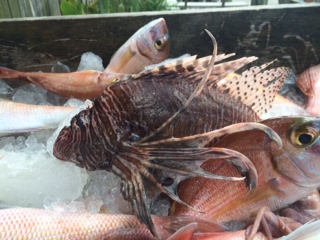
by Rick O'Connor | Feb 28, 2018
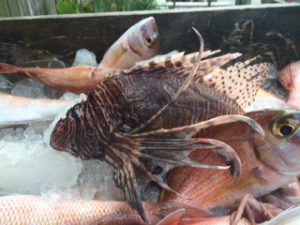
Lionfish caught on rod and reel. Photo Credit: Alison Rogers
Since the first lionfish was spotted off Pensacola in 2010, panhandle organizations have been busy trying to control the spread of this invasive species. The story is well known to many… the lionfish is a voracious predator, consuming at least 70 different species of small reef fish, including vermillion snapper. They reproduce frequently, producing an average of 25,000 eggs/female every four days – and they breed during most of the year. The densities of these fish on our nearshore and offshore reefs are some of the highest in the South Atlantic region, and they prefer artificial reefs to natural bottom. We know they have spread across the northern Gulf to include all five Gulf states and are found in Mexican waters.
We also know that the primary method of removal is still spearfishing. The state of Florida has an open season on them and provides a program to assist local divers with selling their harvest. There are several rodeo tournaments along the Gulf coast and some traditional fishing tournaments have created a category for them. Education programs about the problem continue and some restaurants have offered them when they can get them.
So how are things going?
Are we on top of controlling the lionfish?
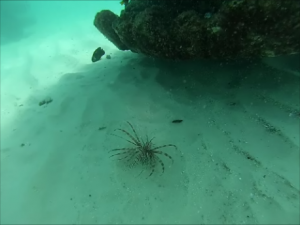
Lionfish at Pensacola Beach Snorkel Reef. Photo Credit: Robert Turpin
Anecdotal reports suggest we have made some impact. Local divers in the Pensacola area report that the shallower public reefs frequented by local divers and dive charters have indicated they are getting harder to find. There have been some tour trips, taking out of town residents diving for lionfish, where they have had to really search to find them. This is certainly encouraging and a numerical assessment of this is needed. However, there are also reports of charter fishing boats catching them on hook and line in deeper waters. They are not catching many, but they do occasionally grab them. When they do, it is usually on live bait and in deep water, 200 feet or so. Local divers seem to agree with this. They too find more lionfish, and some large ones, at depth – too deep to take a typical dive charter trip to remove.
Recent research has shown that lionfish are able, at least in the northern Gulf of Mexico, to swim greater distances than once thought to re-colonize reefs that have been cleaned. One study showed that selected artificial reefs, which were completely cleaned of lionfish, had restored lionfish populations, both young and old fish, within a year. This same study suggests that to keep lionfish at relatively low-density (about 5 lionfish/100 m 2) reefs would need to be cleaned every two months.
Several lionfish derbies occur along the Florida panhandle, but not at the frequency that may be needed to control re-colonization of shallower reefs by lionfish from deeper ones.
Can we increase the number of derbies?
Sure… but those who work on these derbies know the time and financial commitment required to put one on. It could happen that the number of local derbies would increase but we may have to think of other means of controlling lionfish.
One idea is to increase the number who harvest commercially. To do so a diver would need to acquire a saltwater products license from the Florida Fish and Wildlife Conservation Commission (FWC). On their website, they provide the application and a list of approved buyers for the diver to contact. http://www.myfwc.com/Lionfish.
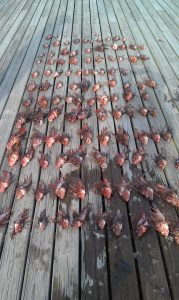
Harvested lionfish. Photo Credit: Bryan Clark
One drawback to the commercial idea is the price. Currently divers require a high price for their catch in order to cover cost and show a profit. These high prices equate to high prices at local restaurants, higher than the public may be willing to pay. One unpublished study shows that some locals are willing to pay more for a lionfish dinner if they know it is helping the environment. Many seafood lovers understand the high cost of lobster, but have not placed lionfish in the same category and are not as willing to pay higher prices; this may have to change. Research continues on developing a lionfish trap that has low by-catch rates. If an effective trap is developed, they could be deployed from vessels, which would not require diving, and could bring prices down.
There is evidence that populations of small reef fish have significantly declined since 2010. Whether this was due to the oil spill, the lionfish invasion, or a combination is still not certain. It is known that local reefs that are cleaned of lionfish are repopulated with both large and small lionfish. We have had some success with removing but we still have work to do.
Reference
Dahl, K.A., W.F. Patterson, R.A. Snyder. 2016. Experimental Assessment of Lionfish Removals to Mitigate Reef Community Shifts on Northern Gulf of Mexico Artificial Reefs. Marine Ecology Progress Series. Vol 558. Pp: 207-221.
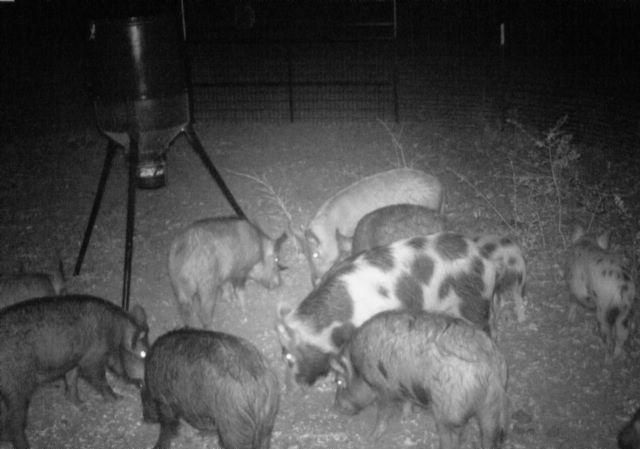
by Jennifer Bearden | Feb 28, 2018
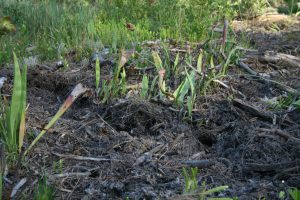
Hog rooting damage in a pitcher plant bog. Photo Credit: Jennifer Bearden
Despite efforts by public and private land managers, feral hog populations continue to rise in many areas in Florida. Feral hogs damage crop fields, lawns, wetlands, and forests. They can negatively impact native species of plants and animals. Their rooting leads to erosion and decreased water quality.
There are several options for controlling feral hogs. Choosing the right option depends on the situation. Options include:
- Hunting with dogs,
- Hunting with guns,
- Box Traps,
- Corral Traps.
Let’s talk about these options.
Hunting with dogs is really not very effective for removing enough hogs to control populations. Dog hunting can move sounders of hogs from areas where damage is occurring for a period of time. This can be helpful when crops need to be protected from hog damage until they can be harvested.
Shooting hogs also is not effective for removing large numbers of hogs. Situations where it is successful include protecting crop fields and for taking hogs that will not go into a trap. Shooting success depends the education level of the hogs and the sophistication of the shooting equipment available. Hogs learn quickly to avoid danger. They learn by watching other hogs who get shot or trapped. Hunting pressure can disrupt hog patterns and make them harder to trap or hunt.
Box traps can be effective at trapping young hogs that are not trap smart. A study conducted by a graduate student, Brian Williams, at Auburn University looked at the efficacy of different trap styles. Young hogs entered box traps and corral traps at similar rates. The study also found that adult females were 120% more likely to enter corral traps than box traps and adult males were more reluctant to enter either trap style but were more likely to enter the corral traps. (Williams et al, 2011)
Corral traps are shown to be most effective for eliminating complete sounders. By eliminating a sounder at once, populations can be reduced. Corral traps are also more economical. In the Auburn study, the trapping cost per pig for box traps was $671.31 and for corral traps was $121.28.
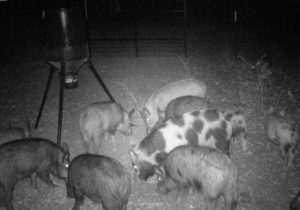
Sounder of hogs in a corral trap. Photo Credit: Jennifer Bearden
Corral traps are best for capturing whole sounders. Box traps can be effective for capturing young hogs. When trap smart adult females or males are in an area, shooting or hunting with dogs are options. Just remember that hunting pressure often just moves the hog problem onto another property. In order to eliminate hogs from a given area, we must employ several of these strategies. For example, we may be able to trap a sounder in a given area but still have a group of boars that will not go into a trap. In this case, we may set up to shoot them after trapping the rest of the hogs in a corral trap. By using these two techniques, we can drastically reduce the number of hogs in an area.
For more information about feral hogs, go to http://articles.extension.org/feral_hogs.
Reference: Brian L. Williams, Robert W. Holtfreter, Stephen S. Ditchkoff, James B. Grand Trap Style Influences Wild Pig Behavior and Trapping Success. Source: Journal of Wildlife Management, 75(2):432-436

by Jennifer Bearden | Feb 27, 2018
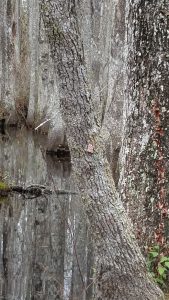
Wetland area on Hurlburt Field Air Force Base has been invaded by channeled apple snails. Photo Credit: Lorraine Ketzler
When you think of snails, you probably aren’t thinking about scary monsters that have been unleashed to terrorize us all. I’m here to warn you that you should. The channeled apple snail (Pomacea canaliculata) is a known agricultural pest that competes with native snail species. In our area (panhandle Florida, Hurlburt Field to be exact) this snail is consuming unknown quantities of plant material in our sensitive wetlands. If you didn’t know, Hurlburt Field Air Force Base is one of the last places on Earth where the endangered reticulated flatwoods salamander (Ambystoma bishopi) can still be found, and this endangered salamander relies on healthy wetlands and ephemeral ponds for breeding.
So why should you worry? Just think about how snails eat: snails have a tongue (a radula) with teeth-like structures (denticles) they use to rasp or drill into their food. Normally, nobody would really worry about what snails are eating; they’re snails, right? But, here comes the scary part: when there are many snails, all eating and breeding and growing and eating, they consume a lot of material. And, what once was a cute little snail in your 10-gallon aquarium becomes a rampaging menace when you dump your tank out in the ditch next to your house and the snail escapes into the wild!
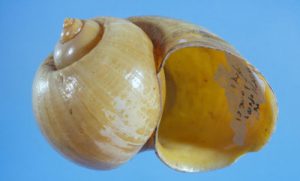
Channeled applesnail, Pomacea canaliculata (Lamarck, 1819). Photograph by Jeffrey Lotz, DPI. Click on the picture for more information on apple snails in Florida.
Ok, let’s be honest, it’s not like snails are running wild. I mean, they’re as slow as…well…snails. But what we believe began as a dumped aquarium pet some years ago has become a large population that is expanding into our wetlands. Although it is currently not found in our salamander breeding ponds (whew!), if we don’t do something to stop it, it soon could be. Here we are in Florida, where we have many examples of dumped or escaped animals that are breeding and growing and eating and breeding with no population control. This is one heck of a great example of an invasive species.
So, what are we going to do about this creeping, slimy, menace? Well, in our case, we called our invasive species contractor, and this year we will begin a labor-intensive project to control this species’ population on Hurlburt Field. We could use your support! Please use the IveGot1 app or EDDMaps to report local encounters with channeled apple snails. And, please DO NOT release non-native wildlife into the wild!
Guest Author:
Lorraine “Rain” Ketzler
Associate Wildlife Biologist
Hurlburt Field Natural Resources Manager


















